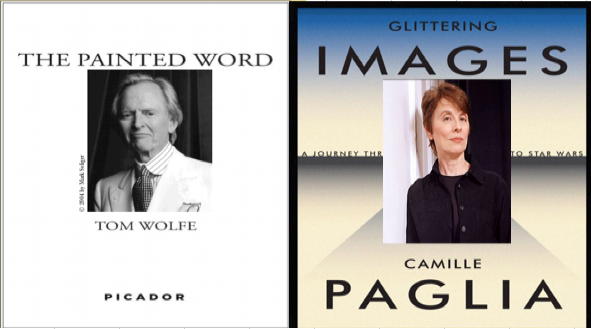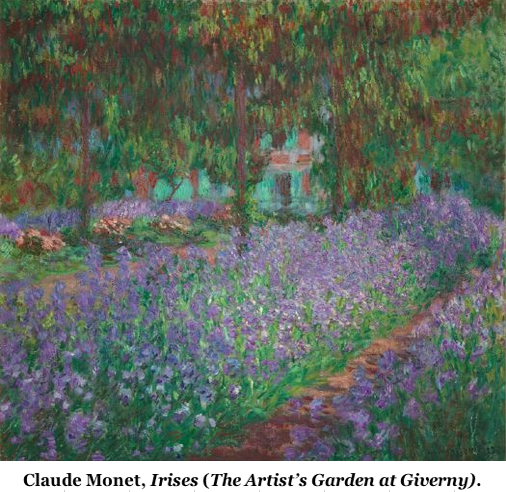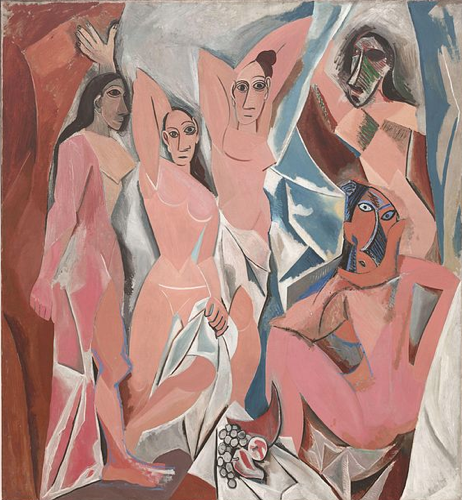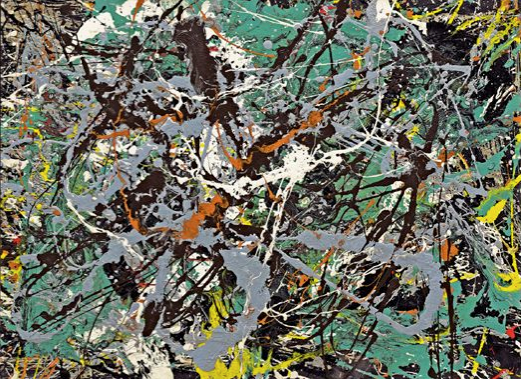Aesthetics and Sociology of American Modern Art
Both Camille Paglia and Tom Wolfe are Yale PhDs. Paglia in English Literature and Wolfe American Studies. Both are multi-disciplinarians, not limiting themselves to their respective college majors. Paglia writes extensively about the arts generally (literary, visual, pop, low and high-brow, ‘what-ever’). Wolfe became a journalist and writer of both fiction and non-fiction books. Both writers expound on the arts in broad multidiscipline psychological, historical, sociological and cultural terms.
However, while both share a common multidiscipline approach to visual arts, each has their individual emphasis; using methods that they uniquely developed: Paglia’s “image analysis” and Wolfe’s “New Journalism”.
Paglia seeks and experiences, explicates and teaches, what may be called the purely aesthetic aspects of a work.
Consider for example, her descriptive vocabulary of the this Monet painting “Irises”: stabbing choppy strokes … graceful splayed … tactile … slashing … contours dissolving in atmosphere … (e-book Location L 1441)
Wolfe’s vocabulary and writing style uniquely blends literary style and (what I would call) social scientific modes of writing.
Thus for example, in “The Painted Word” he describes, in near poetic terms, his response to a New York Times art review:
“Yet another clam-broth-colored current had begun to roll over me, as warm and predictable as the Gulf Stream … a review, it was, by the Times’ dean of the arts, Hilton Kramer, of an exhibition at Yale University of “Seven Realists,” seven realistic painters … when I was jerked alert … (L 35)
Just when the reader thinks he is reading a book by another would be poet, Wolfe springs a fascinating set of social statistics that I would wager have never before been seen in an art history book. He writes:
“If it were possible to make one of those marvelous sociometric diagrams that sociologists tried to perfect in the 1950s … in such a diagram of the art world, we would see that it is made up of culturati and artists [in the following cities]
|
750
|
Rome
|
|
500
|
Milan
|
|
1,750
|
Paris
|
|
1,250
|
London
|
|
2,000
|
Berlin, Munich & Dusseldorf
|
|
3,000
|
New York
|
|
1,000
|
scattered around the world
|
“That is the art world, approximately 10,000 souls— a mere hamlet!— restricted to les beaux mondes of eight cities.” (L 204, table adapted from text for emphasis).
Mass Media ‘spark’ For Both Writers
Interestingly, quintessential literati Wolfe and Paglia both cite the inspiration for their respective books coming from mass media: Wolfe the New York Times, and Paglia AM Radio.
Wolfe knows the precise moment of conception of his 1975 book “The Painted Word”. He writes:
“On the morning of Sunday, April 28, 1974, [I was reading] Arts & Leisure, Section 2, page 19, of the New York Times …when all at once an extraordinary thing happened: I notice something!” (L-31).
The “something” was a single sentence. A sentence that no doubt, given the vast international circulation of the Sunday Times in 1974, untold thousands of people read and passed over while sipping coffee and nibbling a croissant. But, for a man like Wolfe, an art aficionado steeped in art history and a creative writer, the “something” sentence was pregnant with the sociological and cultural implications of Modern Art.
Similarly, Paglia, a virtual encyclopedia of art history, locates the origin of her book about Art in a mass media experience – AM Radio, no less. She writes:
“This book was inspired by my dismay at the open animosity toward art and artists that I have heard on American AM talk radio over the past two decades. (L-103).
Again, while great masses listened to the same radio programs and then went about their business, the programs fired Paglia’s scholarly and creative mind.
Modern Art … Heraclius’ River
Both Paglia and Wolfe see art history in terms of the ancient Greek philosopher Heraclius’ famous paradoxically river metaphor: “You can never step into the same river twice”; i.e. the ‘same’ river (e.g. Hudson) is constantly ‘changing’ (flowing).
Paglia writes:
"The most important question about art is:what lasts, and why? Definitions of beauty and standards of taste are constantly changing, but persistent patterns obtain. (L123).
Like Heraclius’ “river”: the same “patterns persist”; yet aesthetic concepts of “beauty” and “taste” are “continually changing” (‘one can never aesthetically experience the same pattern twice’ … so to speak).
Wolfe provides a good example of the juxtaposition of “persistent patterns” and changing aesthetics in the Modern Art movement. He writes:
“In Europe before 1914, artists invented Modern styles with fanatic energy— Fauvism, Futurism, Cubism, Expressionism, Orphism, Suprematism, Vorticism— but everybody shared the same premise: l’art pour l’art, (L76).
The Modern Art ‘river’ was always the same, i.e. “the same premise: ‘art for art’s sake’, but the “styles/patterns” (Fauvism, Futurism, Cubism, etc.) continually changed.
Both Paglia and Wolfe discuss the unchanging Modern Art “premise” ‘art for art’s sake’, and the changing “styles/patterns” such as Abstract Expressionism and Pop Art.
What does it mean to “SEE art”?
Every year millions file though places such as the Sistine Chapel and art museums around the world to “see” the artworks. Or, at least they thought they were “seeing” art. No doubt they were looking at artworks, but were they seeing artworks?
To the culturati, the meaning of “seeing” art is not (no pun intended) ‘obvious’. Both Wolfe and Paglia raise the issue of the meaning of seeing art at the beginning of their respective books.
“Seven Realist” Art Exhibition Yale University 1974
In 1974, Yale University had an art exhibition of seven artists working in the “Realist” genre: Philip Pearlstein, William Bailey, Syliava Mangold, Paul Wiesenfeld, Janet Fish, Steve Posen, Duane Hanson.
Selective examples of their ‘Realist’ work, but not necessarily those shown at the Yale Exhibit:
Hanson
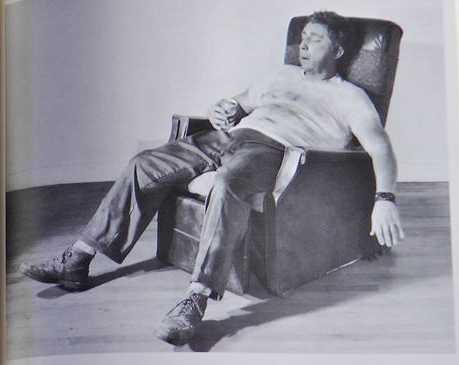
Bailey
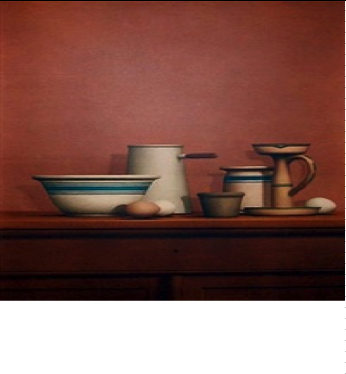
Pearlstein
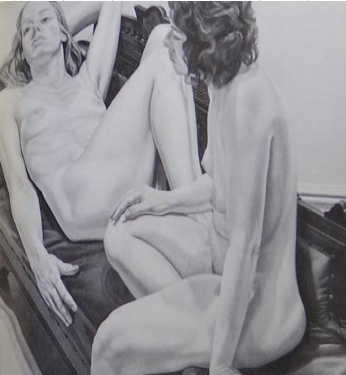
Wiesenfeld
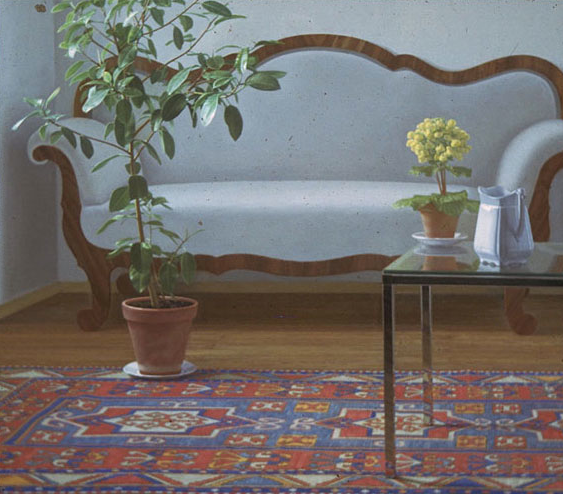
Mangold
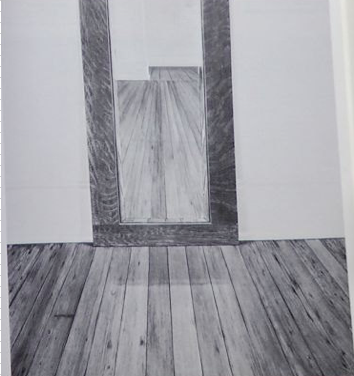
The Yale exhibit was reviewed in the Hilton Kramer New York Times article cited above, which gave rise Tom Wolfe’s book.
Specifically, regarding the “something” in the New York Times that so ‘rocked’ the art aficionado and motivated him to write a book about Modern Art, Wolfe quoting “The Times’ dean of the arts, Hilton Kramer”:
“ ‘Realism does not lack its partisans, but it does rather conspicuously lack a persuasive theory … to lack a persuasive theory is to lack something crucial— the means by which our experience of individual works is joined to our understanding of the values they signify.’ ” (L 35)
‘To my mind’: the key word here is “signify”(i.e. to denote: ‘meaning’ …a sign or ‘indication of’ … ‘suggest’ or ‘imply’).
Thus, Kramer is saying that a work of art “indicates”, “suggests”, or “implies” values. In order for the viewer to “understand” what values are being “signified”, the viewer must combine “theory” with the “experience of [viewing] the [artwork]”.
Wolfe’s response to Kramer:
“What I saw before me was the critic-in-chief of The New York Times saying:
In looking at a painting today, ‘to lack a persuasive theory is to lack something crucial.’
“In short: frankly, these days, without a theory to go with it, I can’t see a painting.” (L44).
My understanding of this Wolfe/Kramer art tete-a-tete:
Kramer posits that images in an artwork signify values. However, values may also be signified with words.
Hence, the title of the book “The Painted Word” …this does not mean words written with paint. Rather, painted images are substitutes for words.
Wolfe writes:
"Modern Art has become completely literary: the paintings and other works exist only to illustrate the text"( L62).
{i.e. to my mind: text =literary =words …ergo the "Painted Word[s]"}
Interestingly, Paglia writing thirty-six years after, and perhaps influenced by, Wolfe uses a literary allusion when discussing a Jackson Pollack painting:
"Pollock’s trance state, drawing on unconscious depths, resembled Surrealist automatism, a literary practice that had never before succeeded with painting. It was as if the anxious or obnoxious Pollock were taking dictation from a higher, more enlightened self. (L 2051).
However, in literary arts, words explicitly express (denote) the values.
In the visual arts, values, signified by images, have to be logically inferred.
Such a logical inference entails some theory.
Viewers must have some theory to connect their experience of the work (i.e. the images they look at) with the values implied by the images.
In short, one does not simply see in the physiological sense of the word. Rather, seeing is a cognitive process whereby, the mind applies a theory to the visualized image and deduces a conclusion about the implied values inherent in the images.
Hence, what Wolfe means: “without a theory to go with it, I can’t see a painting.”
Paglia, again perhaps influenced by Wolfe, also raises some issues about seeing:
“Modern life is a sea of images. Our eyes are flooded by bright pictures and clusters of text flashing at us from every direction. The brain, over stimulated, must rapidly adapt to process this swirling barrage of disconnected data. (L 53-55).
“… in this age of vertigo … Amid so much jittery visual clutter , it is crucial to find focus … (L57-58).
For Paglia, one has to mentally learn how to focus (see) a work of art.
Seeing per Paglia is not simply physiological perceptions (e.g. colors, shapes, etc.).
Seeing is a cognitive process.
Seeing is a learned and teachable skill, and one has to learn how to see artworks. She writes:
“We must relearn how to see …The only way to teach focus is to present the eye with opportunities for steady perception —best supplied by the contemplation of art. Looking at art requires stillness and receptivity, which realign our senses and produce a magical tranquility. (L60-62).
Both Wolfe and Paglia posit the issue of what do we ‘see’ when we ‘look’ at artworks! Wolfe, motivated by Kramer, engages the implied literary nature of painted works; Paglia the aesthetic perceptual experience.
In short: There is more, much more, to the Modern Art viewing experience than simply looking at a work.
Both writers take the reader through protracted discussions about quintessential artworks; illustrating and explaining aesthetic and sociological concepts of that uniquely human phenomenon (that which differentiates humanoids from their primordial cousins) ART!
To my mind: man is the artistic animal.
Two ‘takes’ on Picasso
While Wolfe and Paglia share some aesthetic experiences and precepts such as responding to mass media art commentary, and the concept of ‘seeing’ art; nevertheless, each posits significantly different analysis of art works. Whereas Paglia studies and articulates the minutia aspects of a work, Wolfe places the work in a broad social context. Consider for example, their respective discussion of Picasso.
Paglia demonstrates her method of “image analysis” in her discussion of Picasso’s Les Demoiselles d’Avignon. She writes:
Picasso’s Les Demoiselles d’Avignon, the most important painting in any American museum, has drawn an enormous body of commentary, but I believe I have noticed and interpreted details that others have missed. (L234).
Consider the vocabulary of her discussion of this work, denoting "misssed details":
torture den … brothel reception room … bored women … hair down … waiting for customers … women locked in her own severe, remote consciousness … like Fates … frigid masters of man’s destiny … (L1482)
Clearly, the “details others have missed” are denoted by moral vocabulary and thus imply moral values. She is making inferences about the work at which she is looking. The vocabulary denotes values inferred from the images based on some moral theory.
Wolfe, to the contrary, brings a significantly different mentality to his art discussion. He is a creative writer who builds narratives and plots in the context of social conditions (e.g. “Bond Fires of Vanities). Whereas, Paglia takes you deeper and deeper into the painting, Wolfe takes you farther and farther out of the painting into the painting's society.
Accordingly, he sees art in a sociological context. He sees, for example Picasso’s work against the backdrop of the whole social dynamic of the post- WW I Modern Art milieu. Picasso to him is a manifestation of sociology and social-psychology that made Modern Art acceptable. For example, he writes:
“Modern Art seems to belong to the post WW I period. (L197).
However, the acceptance of Modern has nothing to do with the public at large. On the contrary, the prominent place of Modern in the post-war art world was determined by the above mentioned:
“approximately 10,000 souls— a mere hamlet!— restricted to les beaux mondes of eight cities.”
More specifically he writes:
“The public plays no part in the process whatsoever. (L199).
“The notion that the public accepts or rejects anything in Modern Art … is merely a romantic fiction,(L208)
The public is presented with a fait accompli (L213).
“Modern Art enjoyed all the glories after the First World War not because it was “finally understood” or “finally appreciated” but rather because a few fashionable people discovered their own uses for it. (L221).
“By 1920, in le monde, to be fashionable was to be modern, and Modern Art and the new spirit of the avant-garde were perfectly suited for that vogue.
“Picasso is a case in point. (L224)
While we have come to think of Picasso as a creative genius whose genius could not be denied by the public at large; on the contrary, Wolfe argues: where it not for the few very rich, virtually no one would have heard of Picasso. For example he writes:
"Modern Art was a success in the United States in no time— as soon as a very few people knew what it was, the 400, as it were, as opposed to the 90 million.
"These were New Yorkers of wealth and fashion, such as the Rockefellers and Goodyears, who saw their counterparts in London enjoying the chic and excitement of Picasso and the rest of Le Moderne and who wanted to import it for themselves. (L262).
Again, note the difference between Paglia and Wolfe on Picasso.
Paglia probes the minute of his work to understand his ‘genius’.
Wolfe suggest that his work would have counted for virtually nothing if it were not for the very rich who embraced him for reasons that had virtually nothing to do with aesthetics; rather, the idiosyncratic notions of vogue.
Jackson Pollock
Again, in the critiques of Jackson Pollock’s work, the respective critical methods are present in Wolfe and Paglia’s work. For example, Wolfe, again with emphasis on the role of the rich in determining ‘what is art’, writes:
"Peggy Guggenheim picked Pollock. He was a nameless down-and-out [bohemian] Cubist. She was the niece of Solomon (Guggenheim Museum) Guggenheim and the center of the most chic Uptown art circle in New York in the 1940s, a circle featuring famous Modern artists from Europe (including her husband, Max Ernst ) who were fleeing the war, Uptown intellectuals such as Alfred Barr and James Johnson Sweeney of the Museum of Modern Art, (L401).
Paglia, sees Pollock differently.
Using her “image analysis” technique to critique Pollock’s “Green Silver” painting (below); note the adjectives and descriptive phrasing when she writes:
"A small untitled picture now called Green Silver, executed on paper over canvas with enamel and aluminum paint, captures the exhilarating verve of Pollock’s most refined drip style.
"Its luminous loops, curls, and splashes have a charming playfulness. Against an aquamarine background swoop calligraphic spurts of muted color and spidery black dashes, producing a bubbling ferment.
"Is it ocean, air, sky? The picture is a weather system and mental universe, a neurological map crisscrossed by image and impulse. There is no solitude or alienation here. Green Silver is an ecstatic jabber of chance spills, bursts, and skidding phrases. (L 2043).
Paglia’s Italian Influence
Paglia reports how she came to develope her “image analysis” method and looking for “details” in a painting:
“My thinking about art was impacted by … my immigrant family, with their meticulous virtuosity in the crafts of sewing, tailoring, barbering, carpentry, masonry, metalwork, basketry, and leather working, also conveyed the age-old Italian philosophy of admiration of beauty and veneration for art and artists. (L225)
I highlight “sewing, tailoring” because they bring to mind the only positive scene in what is one of the most profound denigrations of Italians in film history – “Gomorrah”.
In that scene the dressmaker picks up the dress on which a seamstress was working. He brings it up close to his eye to see the details of the stich and then instructs the worker.
Similarly, in the documentary about the famed Italian fashion designer Valentino, there are repeated scenes where Valentino has tantrums because some detail of his design falls short of his standards of perfection.
Paglia learned from Italian immigrants that beauty is a function of meticulous perfection in craftsmanship. Italy today is the world’s art museum because for almost three-thousand years Italian craftsmen perfectly laid bricks, perfectly painted frescos, perfectly assembled mosaics, etc.
In turn, Paglia looks to the details in the artworks she critiques. What she calls image analysis is analogous to the Gomorrah dressmaker inspecting the minutia of the seam.
In conclusion
I don’t mean to draw to fine a line between the Wolfe and Paglia’s discussions of Modern Art. It is not an either-or: either “milieu” or “image analysis”. Both methods are present in the work of each. Paglia certainly comments on the cultural milieu in which a work is created. And, Wolfe notices the details and nuances in the works.
However, Paglia’s historical writing is ‘stiff’, ‘proforma’, ‘matter-of-fact’, ‘Wikipedia-esque’. She is not a social historian. The difference between her prose when writing social history and aesthetics is dramatic. It’s almost as if two different people were writing. Not so ‘tongue-in-cheek’, having experience as a graduate assistant, I can’t help but wonder if a graduate student wrote the social history parts of her book; certainly it’s of that caliber.
And yet, when the historical narrative segues into the aesthetic (Oh My!), the sentence structures, phrasing and vocabulary all indicate a writer, a thinker, passing into her ‘zone’. Its eloquence … Joe DiMaggio and Michael Jordan come to mind. In her zone, Paglia is definitely a ‘long-ball hitter’! In her aesthetic text, the real (dare I say Italian) creative, passionate lover of the beauty born of perfection, Paglia emerges. To my mind: she has no equal when it comes to aesthetic commentary.
On the other hand, Wolfe’s ‘zone’ is social history and especially in class analysis. “The Painted Word” is reminiscent of his absolutely brilliant 1970 book “The Radical Chic”. In Radical Chic he describes and discourses about the super-rich like Leonard Bernstein who invited Black Panthers to their Park Avenue condominiums. Bernstein had Don Cox (“Field Marshall of the Black Panther Party") come to his sumptuous “duplex”. Five years later (1975) in “The Painted Word” Wolfe discusses superrich such as Peggy Gugenhiem having Jackson Pollock to a party at her house.
In short, the difference between Wolfe and Paglia is a matter of emphasis and predominance that differentiates their commentaries; whereas, Wolfe is predominately concerned with the milieu, Paglia with the minutia of the painting.
Accordingly, a student of Modern Art would do well to read the works of both. They perfectly complement each other and present Modern Art in its totality. The detail characteristics of given painting is the product of an artist responding to their social and cultural milieu.
...........
Students of Italian American culture would do well to consider how the Italian American culture influenced Camille Paglia. She is one of ours – no doubt! How so? That is not obvious. And the fact that she is largely not known to us may be symptomatic of the ever-shrinking Italian American culture, as we recede farther and farther away from Little Italy … Public Television’s “Last Hurrah” efforts to keep that tradition alive with four hour long documentaries aside!
